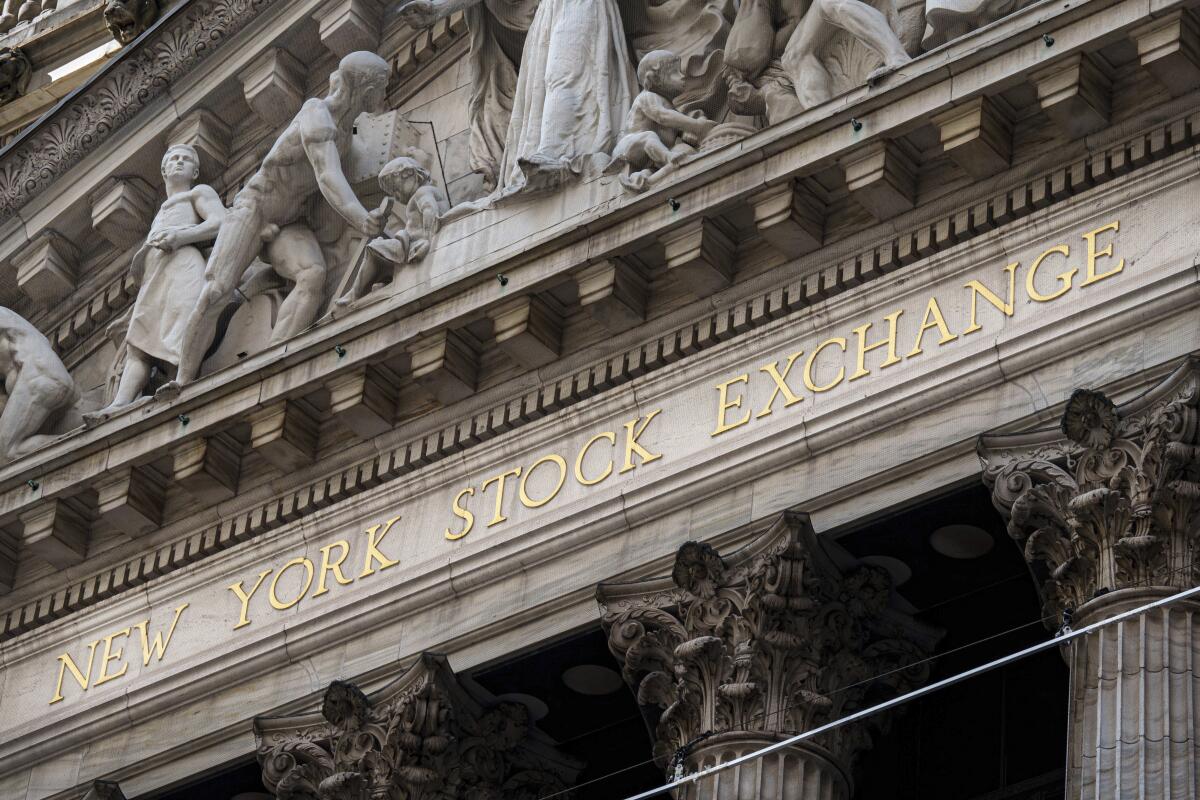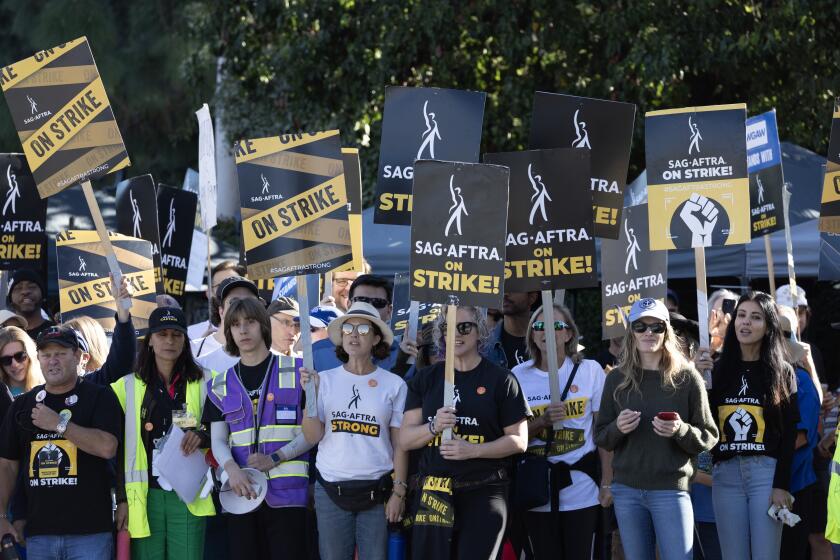Wall Street rises ahead of Friday’s jobs report to snap a 3-day losing streak

- Share via
Wall Street rose Thursday to snap its first three-day losing streak since Halloween.
The Standard & Poor’s 500 index climbed 36.25 points, or 0.8%, to 4,585.59. The Dow Jones industrial average added 62.95 points, or 0.2%, to 36,117.38, and the Nasdaq composite jumped 193.28 points, or 1.4%, to 14,339.99.
Big Tech stocks helped power the market higher, led by a 5.3% leap for Google’s parent company, Alphabet. They’re Wall Street’s most influential stocks because of their massive size, and they have been on huge tears this year.
Cerevel Therapeutics jumped 11.4% after AbbVie announced an $8.7-billion deal to buy the company and its pipeline of candidates for schizophrenia, Parkinson’s and other diseases. AbbVie added 1.1%.
The Otis College of Art and Design recorded a 17% employment drop in the entertainment industry in Los Angeles during the Hollywood strikes.
Wall Street has rallied toward its best level since March 2022 largely on hopes that the Federal Reserve is finally done with its barrage of hikes to interest rates, which are meant to get high inflation under control. That has anticipation high ahead of a report Friday, the U.S. government’s latest monthly update on the job market.
The Fed wants to see the job market slow by just the right amount. Too much weakness would mean people are out of work and could lead to a recession, but too much strength could add upward pressure on inflation.
So far, anticipation is rising that the Fed can nail a perfect landing for the job market and overall economy. Inflation has been slowing since hitting its peak two summers ago, and expectations are building that the Fed’s next move will be to cut interest rates next year.
A report Thursday said that slightly more U.S. workers applied for unemployment benefits last week, though the number is not alarmingly high and hit economists’ expectations exactly. That had both stock and bond markets relatively calm and waiting for Friday’s report, which could be more impactful.
The yield on the 10-year Treasury rose to 4.14% from 4.12% late Wednesday. It’s been generally easing since topping 5% in October and hitting its highest level since 2007.
The holiday season is here, and with it ubiquitous guides to smart gadgets and tech toys. But what about the products we’re better off without? Our experts weigh in.
The drop in the 10-year yield over the last month, including after accounting for inflation, is one of the reasons that strategists at Goldman Sachs say the S&P 500 looks like it’s trading “roughly in line with fair value,” even after its nearly 9% rise through November. Expectations for a healthy economy that avoids a recession have also helped to boost stocks.
But the path ahead could travel down one of several forks, depending in part on how quickly inflation continues to cool and whether the Fed does cut rates by as much as traders are expecting. Goldman Sachs says traders “are approaching the limits of what could plausibly” be expected for rate cuts without a recession hitting in the near term.
“We believe much of the optimistic scenario is already reflected in US equity prices today,” the strategists, led by Ryan Hammond, wrote in a report.
Since the Fed began its drastic campaign to raise interest rates early last year, traders have several times built up bets for an imminent halt to rate hikes and potential cuts to rates, only to be disappointed each time. Although Fed officials have hinted that their main interest rate may indeed be at a peak, some have said it’s too early to begin considering when cuts could come.
Hopes for easier rates help all kinds of investments, particularly those seen as the most expensive or promising big growth the furthest in the future. That’s helped send Big Tech stocks to their huge gains this year.
Alphabet’s jump Thursday brought its gain for the year to just over 55%. A day earlier, it announced the launch of its Gemini artificial intelligence model. The announcement made few waves on Wall Street initially, and Alphabet’s stock slipped Wednesday, but analysts at JPMorgan said in a report that they “are encouraged to see Google’s progress on this major technology shift.”
Alphabet was the single strongest force pushing the S&P 500 upward, but Apple, Amazon and Nvidia all also rose at least 1%.
Another winner was JetBlue Airways, which climbed 15.2% after it said it may report better results for the final three months of the year than it previously expected. It also slightly lowered the top end of its forecast for fuel costs during the end of 2023.
Crude oil prices have been falling recently amid worries about demand from the global economy falling short of the available supplies. The price for a barrel of benchmark U.S. crude slipped an additional 4 cents to settle at $69.34. It was above $93 in late September.
Gentrification is easy to spot if you know where to look. If homes in your neighborhood follow these trends, gentrification might be on the way.
Brent crude, the international standard, fell 25 cents to $74.05 per barrel.
On the losing end of Wall Street, C3.ai tumbled 10.8% after reporting weaker revenue for the latest quarter than analysts expected.
In stock markets abroad, the Nikkei 225 dropped 1.8% in Tokyo amid speculation about whether the Bank of Japan will ease off its ultra-easy policy on interest rates.
Losses for stock indexes elsewhere in Asia and Europe were more modest.
AP writers Matt Ott and Elaine Kurtenbach contributed to this report.
More to Read
Inside the business of entertainment
The Wide Shot brings you news, analysis and insights on everything from streaming wars to production — and what it all means for the future.
You may occasionally receive promotional content from the Los Angeles Times.













